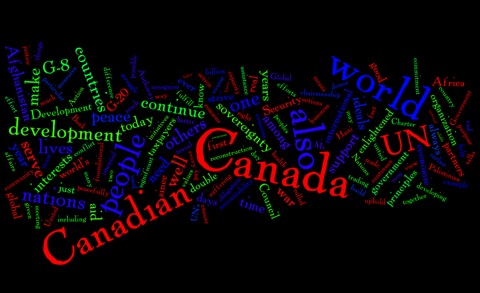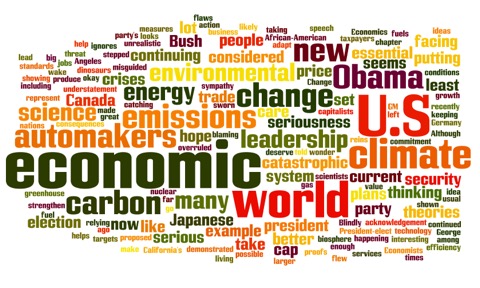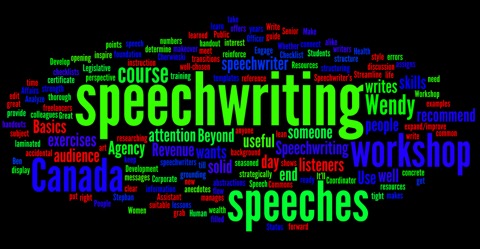What Cirque du Soleil Can Teach Speechwriters
12/12/10 21:30 Filed in: Speeches
Cirque du Soleil combines drama, pageantry, acrobatics and live music into a thrilling treat for the senses. But mesmerized audiences are far less aware of the role communications plays in crafting the excitement on stage.
Take for instance Mystère, the Cirque du Soleil show in residence at Treasure Island in Las Vegas. During every performance, acrobats, comedians, singers and musicians create an out of this world experience for viewers. Yet underscoring the action is a solid foundation of communication designed to keep the audience engaged and focused on the magic rather than the technique.
Chances are, you won’t be able to convince your speaker to do a double back flip at the end of a speech. What you can do, however, is apply some lessons drawn from Mystère to write a better script. Read More...
Take for instance Mystère, the Cirque du Soleil show in residence at Treasure Island in Las Vegas. During every performance, acrobats, comedians, singers and musicians create an out of this world experience for viewers. Yet underscoring the action is a solid foundation of communication designed to keep the audience engaged and focused on the magic rather than the technique.
Chances are, you won’t be able to convince your speaker to do a double back flip at the end of a speech. What you can do, however, is apply some lessons drawn from Mystère to write a better script. Read More...
An Education: In Presentations
29/09/10 22:14 Filed in: Presentations
Here are some great insights and tips from a trio of top presentation designers. Read More...
Working With Word Clouds
29/09/10 22:02 Filed in: Speeches
We speechwriters don’t end up with much to show for our efforts. While the words we write may change what people think, believe or are willing to do, our only souvenir of the assignment might be a paper text, an entry on a Web site (text again), or maybe a video recording of the speaker on the podium. But have you ever asked your friends over to watch the video of a speech you wrote? Probably not…
Well there is a way to create a memento that you could hang on the wall if you were so inclined. Make a word cloud. To do that go to www.wordle.net, follow the simple instructions and congratulate yourself on your artistry.
Wordle is the brainchild of a man who thinks outside the font. His name is Jonathan Feinberg and he developed Wordle as a means of drawing pictures with words. The tool is free and anyone can use it to make word clouds for their own use or to share with the world. Users have licence to do whatever they like with their creations: publish them on paper or online, for instance, or even emblazon them on t-shirts and mugs.
Wordle applies weight to the words in the source text. The more frequently a word occurs, the larger it appears in the word cloud. (Allowances are made for words such as ‘a’ and ‘the’ to keep things manageable.)
So, pour a speech into the hopper, wait a few seconds and then gaze upon the glory of your creation. You can tweak your efforts endlessly to change the colour, font and arrangement. Once you’re happy with the results, save the word cloud as a screen shot and treat it like an image.
Keep in mind, however, that the word clouds Wordle generates are meant to be decorative. They’re not analytical tools. Take for example a word cloud made from the speech Pierre Trudeau delivered on the eve of the 1980 Quebec Referendum. While he was firmly on the ‘no’ side of the debate and said so repeatedly, the word ‘yes’ figured prominently in the word cloud. I suspect Wordle eliminated ‘no’ as a freestanding word because it’s also a common syllable.
Despite the odd glitch, some of which can be fixed with some experimentation, Wordle is a great tool for creating interesting graphics from words. It’s fun to play with too.
Ideas for Using Word Clouds
• Illustrate a Web post of a speech
• Illustrate a newsletter or magazine article about a speech
• Illustrate a cover page for a hard copy of a speech
• Decorate your office wall
• Save in a journal where you document each speech that you write
If you can think of other ways to use them, please add a comment.
Examples of Speech Word Clouds:
The speech Pierre Trudeau gave on the eve of the Quebec Referendum 1980

The speech current Prime Minister Stephen Harper delivered to the
United Nations, September 23, 2010

The speech environmentalist David Suzuki delivered in Los Angeles to the Governors’ Climate Change Summit in 2008

Finally: The description of my workshop Speechwriting: The Basics & Beyond (shameless self promotion)

Well there is a way to create a memento that you could hang on the wall if you were so inclined. Make a word cloud. To do that go to www.wordle.net, follow the simple instructions and congratulate yourself on your artistry.
Wordle is the brainchild of a man who thinks outside the font. His name is Jonathan Feinberg and he developed Wordle as a means of drawing pictures with words. The tool is free and anyone can use it to make word clouds for their own use or to share with the world. Users have licence to do whatever they like with their creations: publish them on paper or online, for instance, or even emblazon them on t-shirts and mugs.
Wordle applies weight to the words in the source text. The more frequently a word occurs, the larger it appears in the word cloud. (Allowances are made for words such as ‘a’ and ‘the’ to keep things manageable.)
So, pour a speech into the hopper, wait a few seconds and then gaze upon the glory of your creation. You can tweak your efforts endlessly to change the colour, font and arrangement. Once you’re happy with the results, save the word cloud as a screen shot and treat it like an image.
Keep in mind, however, that the word clouds Wordle generates are meant to be decorative. They’re not analytical tools. Take for example a word cloud made from the speech Pierre Trudeau delivered on the eve of the 1980 Quebec Referendum. While he was firmly on the ‘no’ side of the debate and said so repeatedly, the word ‘yes’ figured prominently in the word cloud. I suspect Wordle eliminated ‘no’ as a freestanding word because it’s also a common syllable.
Despite the odd glitch, some of which can be fixed with some experimentation, Wordle is a great tool for creating interesting graphics from words. It’s fun to play with too.
Ideas for Using Word Clouds
• Illustrate a Web post of a speech
• Illustrate a newsletter or magazine article about a speech
• Illustrate a cover page for a hard copy of a speech
• Decorate your office wall
• Save in a journal where you document each speech that you write
If you can think of other ways to use them, please add a comment.
Examples of Speech Word Clouds:
The speech Pierre Trudeau gave on the eve of the Quebec Referendum 1980

The speech current Prime Minister Stephen Harper delivered to the
United Nations, September 23, 2010

The speech environmentalist David Suzuki delivered in Los Angeles to the Governors’ Climate Change Summit in 2008

Finally: The description of my workshop Speechwriting: The Basics & Beyond (shameless self promotion)

Speechwriting Tips from Twitter
10/09/10 15:53 Filed in: Speeches
Twitter is a terrific resource for speechwriters. Everyday, scribes from around the world share insights, recommend books and provide links to terrific online resources. If you want to broaden your horizons, join the conversation. An easy way to start is by following me, @wendycherwinski, or the people quoted below. Read More...
Shoot Like a Communicator
29/08/10 14:51 Filed in: Presentations
How often do you wander around with a camera slung over your shoulder or tucked into a hip pocket? Most likely that’s something you do on vacation. And whether you return home with shots of the kids at Disneyworld, or your tour group standing in front of the Leaning Tower of Pisa, chances are most of those photos sit on your computer or disappear into an album to be looked at again someday. Yet, with a bit of thought and planning, your best work could see the light (terrible pun) in your presentations.
Today, importing digital photographs to slides is a snap (another terrible pun, sorry). And there are good reasons to do it. Photographs can set a mood, tell a story, make an abstract concept concrete, elicit an emotional response or spark imagination. Research also indicates that people remember information better and longer when they receive it from images rather than text.
Here’s the simple key to success: be purposeful about capturing images to use on your slides. So, next time you’re looking through a viewfinder, keep these tips in mind.
Take background shots - Grab a few shots that are mostly sky with the scene or activity in a narrow band along the bottom. These shots are great for title or bullet slides. To learn more about this technique read Life Imitates Art, posted elsewhere on this blog. Read More...
Today, importing digital photographs to slides is a snap (another terrible pun, sorry). And there are good reasons to do it. Photographs can set a mood, tell a story, make an abstract concept concrete, elicit an emotional response or spark imagination. Research also indicates that people remember information better and longer when they receive it from images rather than text.
Here’s the simple key to success: be purposeful about capturing images to use on your slides. So, next time you’re looking through a viewfinder, keep these tips in mind.
Take background shots - Grab a few shots that are mostly sky with the scene or activity in a narrow band along the bottom. These shots are great for title or bullet slides. To learn more about this technique read Life Imitates Art, posted elsewhere on this blog. Read More...
Taking care of the ‘risky’ Business of humour
06/07/10 18:18 Filed in: Speeches
Adding humour to speeches and presentations is risky business. The speaker can fluff it. The audience can find it unamusing, confusing, or even worse — offensive. Whatever the negative outcome, poorly chosen or delivered humour can end up clouding the speaker’s message.
Fortunately, the opposite scenario is also highly possible. A little humour can warm up the atmosphere, make the speaker appear friendly and help listeners remember key points.
The secret of success lies in carefully choosing humour that will entertain the audience while keeping the speaker safe. Read More...
Fortunately, the opposite scenario is also highly possible. A little humour can warm up the atmosphere, make the speaker appear friendly and help listeners remember key points.
The secret of success lies in carefully choosing humour that will entertain the audience while keeping the speaker safe. Read More...
